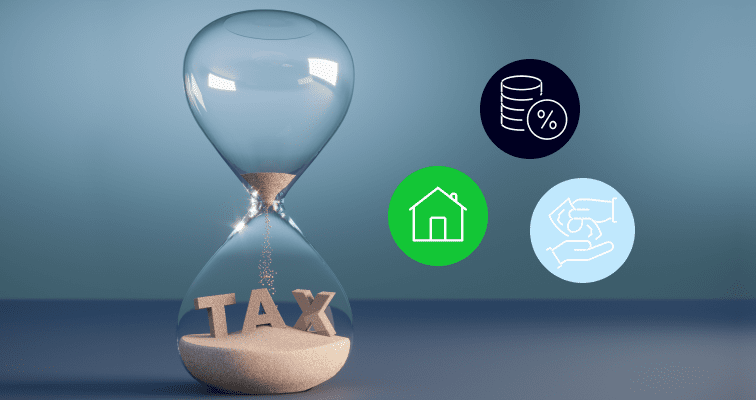When you sell financial assets, there is a possibility that you will need to pay capital gains tax (CGT) on any profits you make. Find out what CGT is, how it works in Portugal, and what you need to know as an investor.
In Portugal, if you buy capital assets and sell them at a higher price, you may be liable to pay capital gains tax (CGT). All investors need to file a tax return providing the details of their transactions and, if liable, make the relevant tax payment to the Portuguese tax authority, Autoridade Tributária e Aduaneira (AT).
This guide will help you to navigate the post-trade environment and outlines what happens when you liquidate capital assets in Portugal. Once you understand how CGT works, and how to calculate it, you may also realise that there are ways of minimising the amount you have to pay.
What is capital gains tax (CGT)?

Capital gains tax is a tax that you may be liable to pay when you make a gain from the sale of a capital asset. In Portugal, the amount of tax that most investors pay on capital gains is set at a flat rate of 28%. This rate is set by the Portuguese government.
While CGT in Portugal is relatively simple, developing a better understanding of how CGT works will not only make it easier to calculate your tax obligations and file your return, but might also reveal ways in which you can reduce your overall tax burden.
Not all capital assets fall within the scope of CGT, and the tax rate applied to different instruments varies. The amount of CGT you pay will be determined by national and regional tax rates, and your personal financial circumstances.
In Portugal, the trigger of a CGT event is the moment you sell part, or all, of a capital holding. These can occur at any time during the Portuguese tax year, which runs from January 1 to December 31. Then, in the following year, there are also some important dates to remember relating to capital gains tax obligations:
- February 15 — deadline to register your household for tax purposes.
- February 25 — deadline for queries made to the e-Fatura portal (the tax authority app).
- June 30 — deadline for submissions of IRS (personal income tax) declarations.
Capital gains need to be reported to the AT, and any tax payment made to it in accordance with the above timelines. Failure to complete the process properly could render investors liable for fines or penalties.
What assets have capital gains tax?
The starting point for your tax analysis is establishing which of your investments fall into the scope of CGT, and which do not.
While not an exhaustive list, investors in Portugal will usually have to pay capital gains tax on profits made from the following assets:
- Shares, securities and similar investments
- Corporate bonds
- CFDs and derivatives
- Mutual funds
- Real estate and real estate funds
- Interest on savings
- Dividends
- Cryptoassets
- Currency trades
- Rental income
- Income from foreign investments and assets. Overseas investments fall into the scope of CGT in Portugal. If the country you move to has a double taxation agreement (DTA) with the Portuguese authorities, then you may be able to avoid paying tax twice. UK residents living in Portugal, for example, pay tax accrued on UK shares to the AT, but not to HMRC.
Tip: Cryptoassets are subject to CGT in Portugal. This change was introduced by the tax authorities on January 1, 2023.
Conversely, some assets can be sold for a profit and not incur a capital gains charge. As always, do your own research, but some popular CGT-exempt assets include:
- Private pensions
- Assets held in a tax-free savings account (TFSA)
- Your main residence if the proceeds are reinvested in another main home
- Personal possessions
When you sell an asset where CGT is applicable, a CGT event will be triggered. In some situations, the payment and processing will be done automatically by your bank or broker, who may automatically “withhold” your capital gain and pay it directly to the Autoridade Tributária e Aduaneira on your behalf.
Tip: When filing your annual tax return, it is your obligation to check that any withheld tax is reported correctly.
Whether you are an active trader with a diversified portfolio or are new to investing, it may be wise to get advice from an experienced tax advisor. They can help to ensure that you do not miss any of your CGT reporting deadlines or obligations, and could even offer suggestions on how to become more tax efficient.
How do I calculate my CGT?

As mentioned earlier, in Portugal, the rate of CGT that investors must pay is set by the government at a flat rate of 28%. While most assets are subject to this flat rate of 28%, you will also find that the CGT rate applied can vary across different asset groups.
To demonstrate how the Portuguese flat rate of CGT works, consider an example:
- If an individual owned shares of energy giant Energias de Portugal SA (EDP) and sold some EDP stock at a profit of €1,000, they would have a tax liability on that sale of €280 (because the CGT rate on stock investments is 28%).
- The net profit on that investment would, therefore, be €720.
If your broker processes the tax payment automatically, they will withhold the €280 amount and pay it directly to the AT on your behalf.
Portugal’s tax code is based on a flat-fee principle, but even with relatively simple instruments such as stocks, there are a series of caveats and clauses. It is important, and can be beneficial, to understand these. In Portugal, caveats include:
- Gains on shares in blacklisted jurisdictions, such as Gibraltar and Guernsey, are taxed at 35%.
- CGT does not apply on assets bought before January 1989.
Calculating how much CGT you owe can be more complicated when considering other asset groups. Even if the flat-fee principle still applies, you may be able to offset some costs against your tax liability. One example would be income from real estate, where the costs of insuring a property are tax deductible.
If you want to calculate your CGT obligations yourself, there are four key stages to work through:
- Calculate your basis: The capital you spent to purchase an asset, minus any commissions or fees you paid.
- Calculate your realised capital gain: The capital you received when you sold the asset, minus transaction fees and commissions. If you were actively trading in a particular instrument, use the average purchase and average sale prices.
- Determine the difference: Subtract the realised amount from the basis to establish if you have made a capital gain or a capital loss.
- Keep track of the deadlines for filing returns and paying the Autoridade Tributária e Aduaneira: The tax year runs from January to December and the deadline to submit your tax filing is June 30 the following year.
Consider contacting the Autoridade Tributária e Aduaneira directly to discuss your CGT situation. The advice offered is free, and the tax authority is the primary source of all Portuguese tax information.
How does CGT impact my other investments?

The main way that CGT will impact your investments is that your net gain after tax will be lower than what you would otherwise have expected to receive. This may encourage investors to consider different investment strategies, such as using a tax-free savings account (TFSA), which is a CGT-efficient method of protecting your investments.
You may also consider adapting your investment strategy over time by speeding up or slowing down the liquidation of assets to occur over multiple tax years, dependent on whether you think that the flat-rate tax level might change.
While in most instances, the amount of tax is determined by the 28% flat-rate approach, as this is set by the government, it could change at any time according to political will. So, monitoring news channels for any indication of that happening could influence your decision on when to sell.
However, regardless of the type of investment course you take, one of the most significant impacts on your investment activity revolves around the need to keep accurate records of all transactions in order to report accurately. Information that is worth archiving includes:
- Details of share dealing transactions
- Details of transaction fees and commissions
- Property transaction details
- Property repair costs
- Accounting and legal costs
How can I minimise my CGT burden?
While you may not be able to avoid capital gains tax entirely, there are strategies you can deploy to minimise the amount you pay.
Take advantage of capital losses
You can net off losses on losing trades against profits made on winning ones. This will lower your overall CGT liability. There are certain conditions that need to be met, and additional tax relief if you reinvest, but if you meet certain criteria, you can roll losses over for up to five years.
Take advantage of tax-efficient investment schemes
Investments held in a tax-free savings account (TFSA) are exempt from CGT. Instruments that qualify for this scheme include stocks, bonds and mutual funds.
Speak to a professional
A tax agent with experience of helping investment clients could offer advice on potential ways of reducing your CGT liability. Guidance from an expert will also provide you with extra confidence that you have optimised your returns but remained tax compliant.
Final thoughts
Capital gains tax is an unavoidable part of investing in Portugal. The flat-fee approach simplifies things to some extent, and as every resident of the country needs to file a tax return, there isn’t too much additional work to do should you decide to invest in the financial markets.
It is important to remember, though, that the responsibility for accurate reporting and timely payments rests with you. Gaining a better understanding of the process can help you to feel on top of the situation, and free up time to research and book winning trades. After all, CGT is only charged when you make a profit.
Join eToro today and learn more about CGT, investing in shares and trading in general.
FAQs
- What is the best way to find out if I owe CGT?
-
If you’re dealing in popular instruments such as stocks and making a profit, it’s highly likely that you’ll be generating a CGT liability. The best way to check is to access your account at your broker and analyse the reported transactions. If you sign up to a high-quality broker, you may find that they generate a tax statement, giving you a summary of the profits you made, and the tax you owe.
- Is there a “wealth tax” in Portugal?
-
There is no overall wealth tax in Portugal, but there is an additional tax applied on properties with a value in excess of €600,000. Properties that fall into this scope face an annual tax rate of 0.4% on the net value if they are owned by companies, 0.7% if held by individuals, and the tax rate climbs to 1.0% if the amount of wealth held in Portuguese property goes over €1m.
- Who makes the payment of CGT to the Portuguese tax authority?
-
This depends on the type of assets in which you are investing. If you buy and sell stocks with a reputable broker, you can expect part of any profits you make to be withheld and paid directly to the Autoridade Tributária e Aduaneira (AT). Other CGT events, such as the sale of a property, are more likely to be processed at the time of completing your annual return — and payment would be made by the individual. You are ultimately responsible for ensuring that all CGT reporting and payments are correct and up to date.
This information is for educational purposes only and should not be taken as investment advice, personal recommendation, or an offer of, or solicitation to, buy or sell any financial instruments.
This material has been prepared without regard to any particular investment objectives or financial situation and has not been prepared in accordance with the legal and regulatory requirements to promote independent research. Not all of the financial instruments and services referred to are offered by eToro and any references to past performance of a financial instrument, index, or a packaged investment product are not, and should not be taken as, a reliable indicator of future results.
eToro makes no representation and assumes no liability as to the accuracy or completeness of the content of this guide. Make sure you understand the risks involved in trading before committing any capital. Never risk more than you are prepared to lose.


